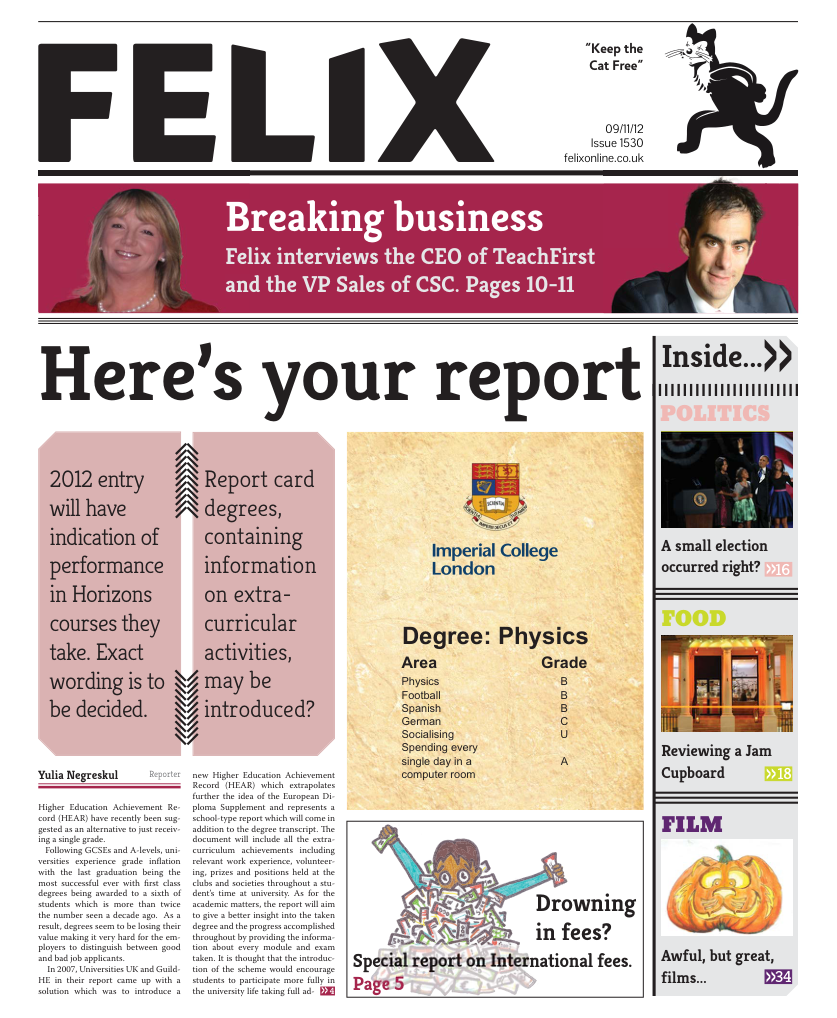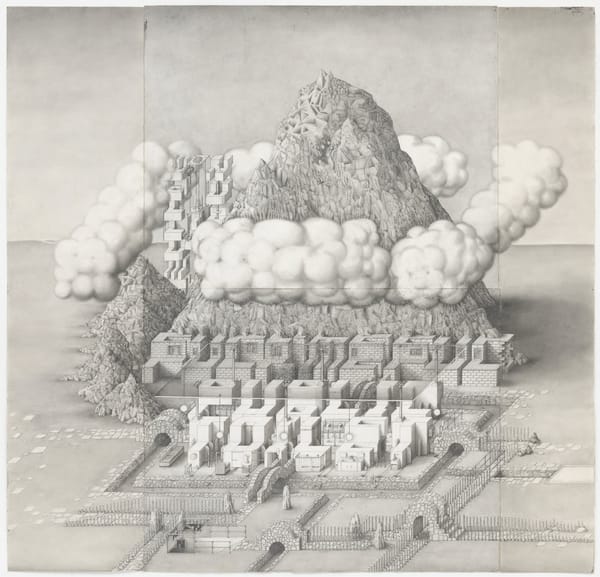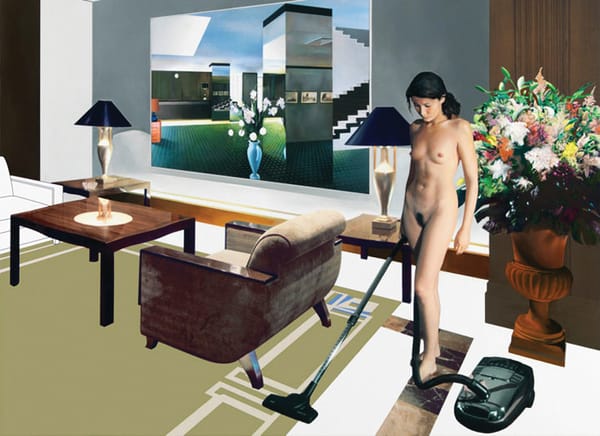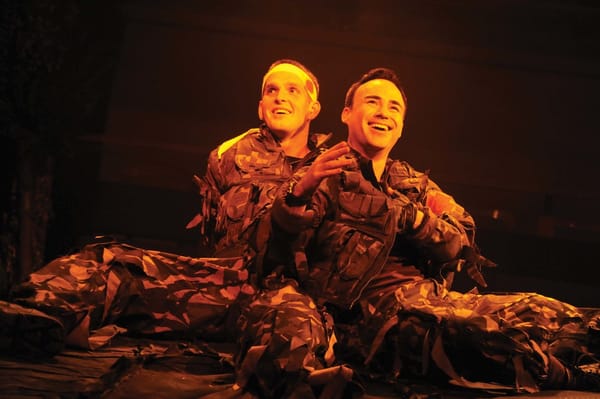Fusion achieved at last in Huxley
An interview with Physics’ artist in residence

I met Geraldine Cox in a windy garet on the roof of the physics building. The abandoned weather station is an octagonal room half-open to the elements and filled with drying clothes, bits of mouldering, esoteric looking equipment and empty beer bottles. It was an appropriately idiosyncratic setting for an interview with a unusual person. Geraldine is the Department of Physics’ artist in residence.
Over the sound of the howling wind we begun to talk about here experiences and her work. As we chatted a rainbowformed over Hyde Park.
Meredith: When did you start this residency?
Geraldine: Well, it’s hazy. I started thinking about connecting physics with art about three years ago. I originally did a degree in Physics then I worked for Accenture for a few years. You don’t need to mention that [laughs]. Then I went to art school for four years. After you’ve learned to be an artist and you’ve learned to paint, you ask yourself – “what shall I make work about? What do I want to say?”
That was why I came here. I had a hunch that there would be something here to talk about, and I had the background to do it.
To me it was personal in the sense that it was like pulling strands together in my mind that are important to me. I really used to love physics and this was an opportunity to combine it with art.
I was incredibly lucky, I went to a talk one night and met the speaker – he put me in touch with Terry Rudolf who works in quantum information. I’d had forgotten all my physics so I started reading books. It was formally, April the 1st, 2011 when the Leverhume Trust paid for an award to do that first year of work. That’s when people started calling me the artist in residence, which is a title that I never have aspired to.
M: How would you describe yourself and your work?
G: I really try to avoid any labels. Sometimes my work is educational or documentary and sometimes it is expressive or poetic. Sometimes it is about the science, sometimes it is about the people. I don’t really worry about it. I call myself an artist, but that is because I am interested in expressing different ideas. But the artist in residence thing is a bit too formal for me.

M: So what did you feel that you could gain from this relationship you have with the physics department... whatever it is?
G: Well, I didn’t have a clear idea when I started. I felt that there were things there that were really worth exploring and expressing as an artist. Other than that I had really no idea what I expected.
I decided that, this is goingto sound a bit flaky, a bit arty-farty, but I decided that I wanted to make work that was really optimistic, about the best that humans can be. It is a really interesting aspect of humanity. I wanted to talk about humans and discovery and how they see the world. I think, philosophically there is a lot that can be learned from science for life in general. There is a sense of the power that it gives you, but also the humility. You understand the limits of your knowledge.
M: How much of a difference did your science background make?
G: Massive. It makes all thedifference. Even though when I started I was incredibly rusty. I read over 30 books in the first year. I couldn’t even think about an electron when I first met Terry.
When I got here I did nothing for three months apart from speak to people, just to find out what was going on in the building, who these people are, how they work. No one has to start from scratch with you, which can be tedious and you can make connections yourself.
It is the idea that you see something here and extrapolate it somewhere else and you get a deeper understanding of physics. It is incredibly exciting. You get these things that just pop up again and again on all these different scales around the world and the universe. That we can even see that and map that is amazing. Yes the physics I think is just a massive help.
M: Has the experiencelived up to your expectations?
G: The thing about being here is that your mind is constantly being stretched because you are always experiencing and thinking of the world in different ways – developing different abstract models all the time. It’s just incredibly exciting. It’s more exciting than a lot of art. The ideas come so thick and fast here and it colours in your mental image of the world. So for me – this is the most stimulating place to hang out. M - Wow! Newsflash! You can definitely have too many physicists in one room. Definitely... more than two [laughs].
My own experience of life is richer because anything I look at has layers of meaning. I can look at the poem I read yesterday that makes me look at the world in a different way, or I can look at what is happening to the light bouncing off the tree down there. It just makes every moment richer. One of the things I am really interested in is how physics identifies patterns. My project is called finding patterns. So that was a notion, and idea I had at the start. I see it really strongly now, the name is really the right name.
M: Do you feel that there is a big void between the art world as you experienced it and academia and the sciences?
G: I have to be so careful with this. You can be so inflammatory. This feels like home to me. I can really talk to people here. Ifeel like I understand the way they think. I am less at home in the art world and I’m not sure why that is.
There is something about the scientist and the engineer, maybe because they are looking outwards and because they are completely beholden to nature somehow. There is a check on them. Whereas artists, they are in a more boy band world and there is a machine operating that selects you and promotes you. It’s a rather mysterious machine based on all sorts of forces. And I couldn’t tell you what they are.
Some people sense that: that artists have an agenda to put out there and they will do that at any cost rather than being open to learning.
Maybe it’s down to education. Maybe it’s just that people don’t have a way in. A friend always says that science is a channel, or a way of looking at the world, as is poetry or painting. The most wonderful thing is to include various aspects of those in your life as ways of talking about your experience of being there and understanding it.
In a way they are complementary, not competing. Part of what I am trying to do is open doors and help people to understand how science can help complement how they understand the world alongside other things.
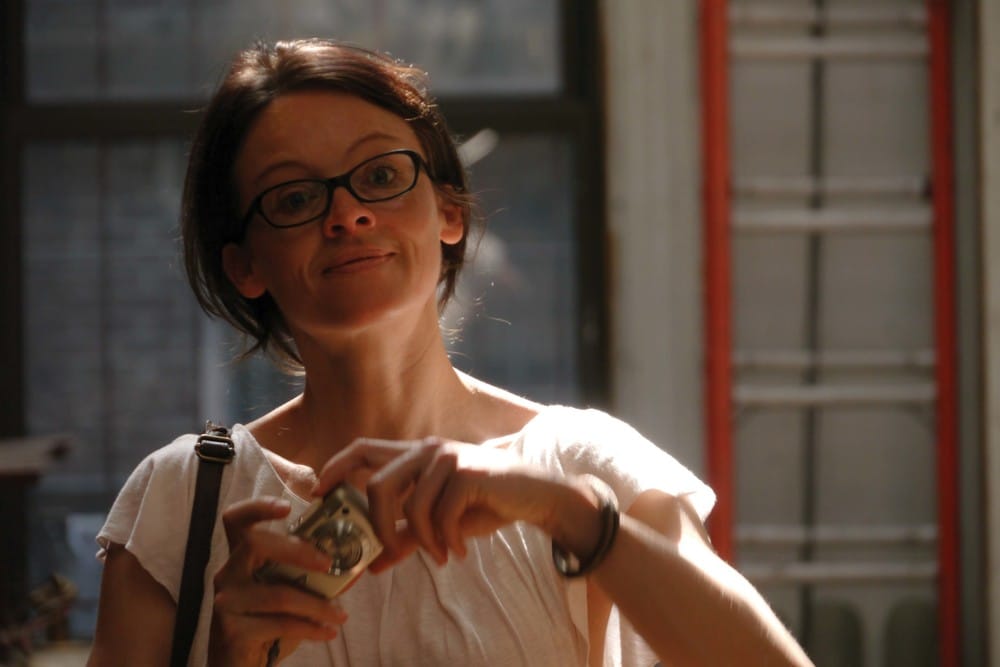
M: Where do you think these differences arise?
G: Maybe our education system silos people too much, separating them out into art and science and having very different ways of thinking. I’m not sure it has to be like that. I meet young people all the time who feel this way and are trying to bridge the gap and talk about the world in all its beautiful complexity by whatever means they can.
I do think that people like black and white and I think everybody could do better if they were more curious about things. More open to uncertainty, which is everywhere.
M: How do you explain your work to scientist and engineers who may be more sceptical?
G: I don’t really come across any overt scepticism, not after the first few minutes. People are very generous with their ideas and time. I always try to listen and learn as openly and attentively as possible and give something back. It is always a dialogue.
M: Can you give me some examples of projects you have worked on while you have been here?
G: I have made so many things and think of each one like a short poem – some hitting the mark or finding resonance better than others
One of the films is called Chalkboard and is something I made with a theoretical physicist. It was images of a chalkboard, which soundsmundane and uninteresting. They were close- ups, using a special lens and the backing track is of his singing. He does this throat singing – producing different voices from one head, I don’t know if you have ever come across that sort of singing. It is probably from Mongolian regions.
It is about a three minute film. Fascinatingly, if you look closely at the chalkboard it takes you to another world, another cosmos opens. The film is really successful at expressing what if feels like to be on the edge of knowledge, to be working in that way. I’m gauging it by peoples’ reactions to it.
The yurt on the roof a little natural light cinema so the yurt has a hole in the roof, so the light flushes through the hole. Our project will work by passing light through an LCD screen so it’s like your film transparency, down onto a table. So the films are being projected on the table just using the light outside. And when clouds go over the image will go darker. I love that idea. You are beholden to nature. What limited electronics you need to run the LCD screen and the speakers. A few watts will come of these flexible plastic photovoltaic cells, so it will just generate it’s own electricity.
It’s a pop up so it can just pop up anywhere. It can go onto the street or into schools, exhibitions or festivals and be this atmospheric, welcoming, non-threatening environment to watch some of these films.
There will be all sorts of different things we could show like Chalkboard for example to give people a sense of some of the work that goes on here in a more sensory way I suppose. It’s the poetics of discovery.
M: Is there something unique about physics because it is so fundamental to our very existence. Do you think you would ever see yourself working other departments?
G: I think I am really attracted to physics. What is it with physics? I think what personally I love the investigation into the inanimate. It is just purely a question of finding out more about the world, no matter how many business cases physicist write to say ‘that this is to make that, or this will help us make that’. Fundamentally it is curiosity based. and I love the purity of that.
There is lots of good work going on other fields. But I think that pure curiosity is probably the essence of my project. And there is a great beauty in the creation of abstract models and testing and applying them around the universe. Like a casting of the human mind. It is a powerful thing to do, but also comes with great limitations inherent in the human mind. This story of power and humility is also a part of my project.
M: Do you ever feel yourself drawn to go into research yourself?
G: I think I don’t have what it takes. I like exploring different ways of expressing ideas and as a friend of mine said the other day: we absolutely do not want self expression in the laboratory. On the theory side, I haven’t got the head for the maths and probably and on the experimental side, maybe I haven’t got the patience.
There is possibly useful work that I am doing. There is something strange about having someone in the physics department who has studied physics and art, who is always asking questions, but never going to ask you whether something is examinable, and who wanders around all the fields of physics.
I’m walking around all the time and asking questions and playing things back to people. Telling it in a different way. People say that it actually helps them think about physics. So there is some role I can play that’s of benefit as an artist. Although it is not helping in any direct way a person’s research. It seems to me that scientists can enjoy the work I produce for the guy on the street as much as the guy in the street.
M - Do you think every department shouldhave a... someone in your role?
G: You know, I really don’t know. It all depends on the people – it’s not something that can necessarily be organised by shipping artists into organisations. There can certainly be great benefits. This is a very personal project for me, it’s very philosophical and personally driven, so I behave in a certain way. The reason I am not looking at working in other departments, is also that I am overwhelmed here. It is a really big department, I’ve changed track so many times in my life, I just can’t go and do it again. This is really enough. This is a big pie to eat.
Find out more about Geraldine’s work at www.findingpatterns.info

